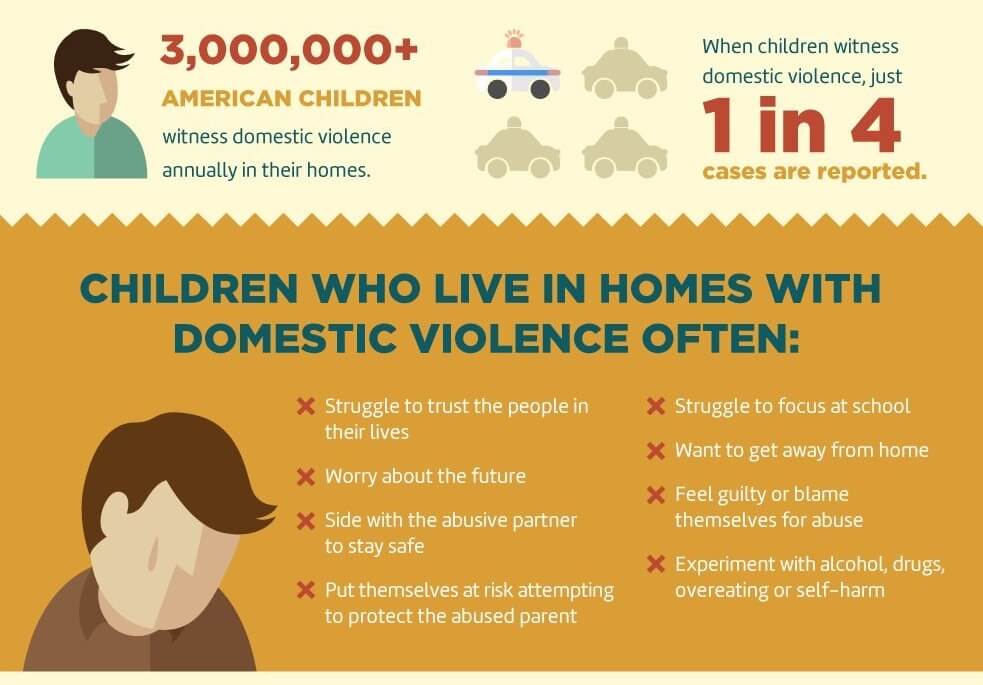They are often referred to as the silent victim of domestic violence.
The children huddled in closets, at the top of the stairs, or cowering behind the couch listening as the verbal and physical abuse occurs. According to the Department of Health in 2003, at least 750,000 children a year witness domestic violence. According to a UNICEF study as many as 275 million children worldwide are exposed to violence in the home. For many years the primary focus was on the adult being abused and finding a way to get the family out of the situation. The idea that once the family is safe everything will be ok is a short sided one.
Children who have witnessed violence will react in many different ways. A large number of children report feeling guilt for causing the fights or not being able to protect the parent during the violence. This guilt can show itself in anxiety, depression, or even anger towards others. Older children may begin to self- harm or use alcohol and drugs to cope with their feelings. It is just as important to provide counseling and avenues of healing for the children as it the adults.
Silence and denial is often a coping skill that the whole family has become so accustomed to that it may be very difficult to begin sharing their feelings with you. You need to be encouraging and supportive of the feelings they are experiencing. You need to tell them that the abuse is never their fault and violence is not ok. Many children of domestic violence have lost their trust and it is important to rebuild it so they can learn to establish healthy relationships as they continue into adulthood.

How to help children heal
The counselor of the Transitional House program here at Women’s Resource Center has some great tips on how to create an environment to support their healing process.
Establishing a routine
Something I talk about a lot with parents when they come into Transitional House is establishing a routine for their family. During the process of leaving an abusive situation they are in a shelter (sometimes 2 or 3), or bouncing from one friend of the family to another. Their lives have been chaotic and children need structure. Once they come to our program or they have their own space/apartment, the kids get settled into a school, and they are hopefully set to spend 2 years in the same place. Kids thrive so much on routine, predictability, and consistency. I think a great way for parents to help their children heal is to provide them with a relatively stable weekly schedule. This will allow them to develop steady relationships and not have to worry about what is going to happen later that day/week/month. This can provide children with feelings of safety and security, and can decrease the need to be vigilant for danger as much.
Nurturing family time
Along the same lines, I think it can be very helpful to children to have rituals they consistently do when coming back home together in the afternoon/evening to reconnect with parent(s)/siblings. This could be very different things depending on the family and age of child…tickle/cuddle time, reading a book together, getting dinner ready together, walk around the block, talking about feelings of the day, etc. Something that is simple, doesn’t take too long (15-30 min), but that a child can count on to have their parent’s attention and care before going on with the business of life. I also recommend this for children going back and forth between two homes. Having a ritual when returning to a parent’s house after being gone for a few days/week to reconnect, review household rules, share feelings can set the tone for the rest of the custodial time. Reviewing rules and sharing feelings can be done in fun contexts like getting ice cream, playing a game, while brushing hair (or some other nurturing activity) so that it is not a drag.
Self-Care Strategies
Finally, self-care is all about finding those unique things to individuals that are soothing. Parents can join their kids in making a list of things that are especially soothing/relaxing to each child. Having a list ready can help in a time of upset when a parent or child may forget what to do or what can help. A list may include a certain kind of touch (back rub, hug, etc), holding a favorite toy/blanket, going outside to yell and run around, a hot shower/bath, putting on a certain song, sipping a cool drink, hearing certain words (“you are ok”, “you are safe”, “I’m right here, I’m not leaving”). Creating a list together can help the parent better calm their child, but also teaches the child to discover how to self-soothe. A similar activity would be to collaborate in discovering the specific triggers children have that cause them to become upset and be able to catch the upset coming on before becoming developing into a full-blown tantrum.
In order to help break the cycle of domestic violence children need to believe that they are good enough to be treated with respect, compassion, and love. They also need to know that they can control their own anger and violence is not the appropriate response. Counseling for the children as well as the family unit is strongly recommended. Most domestic violence centers have counseling resources or can provide you with referrals to counselors.
If you are looking for counseling resources please call our hotline at 760-757-3500.







